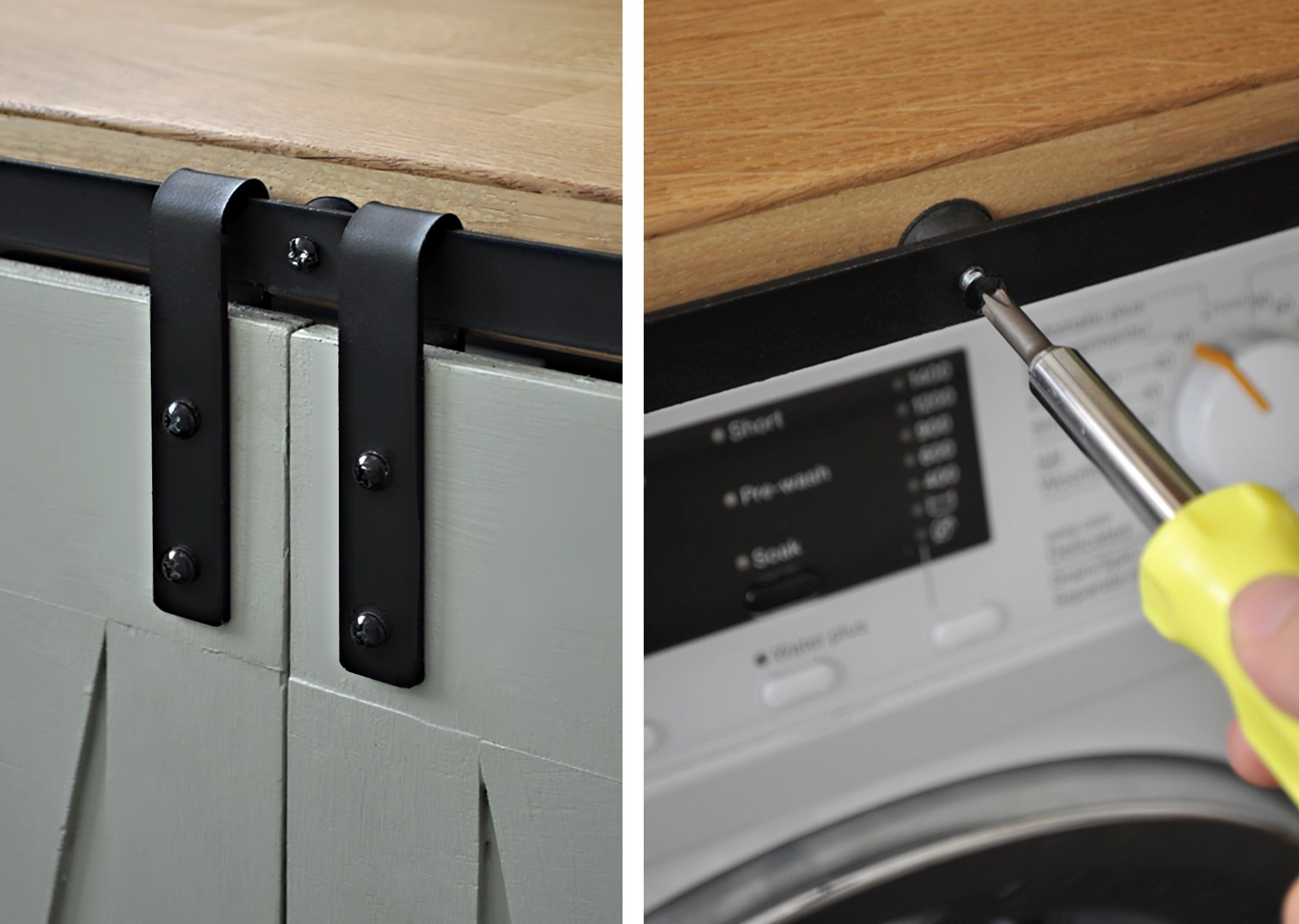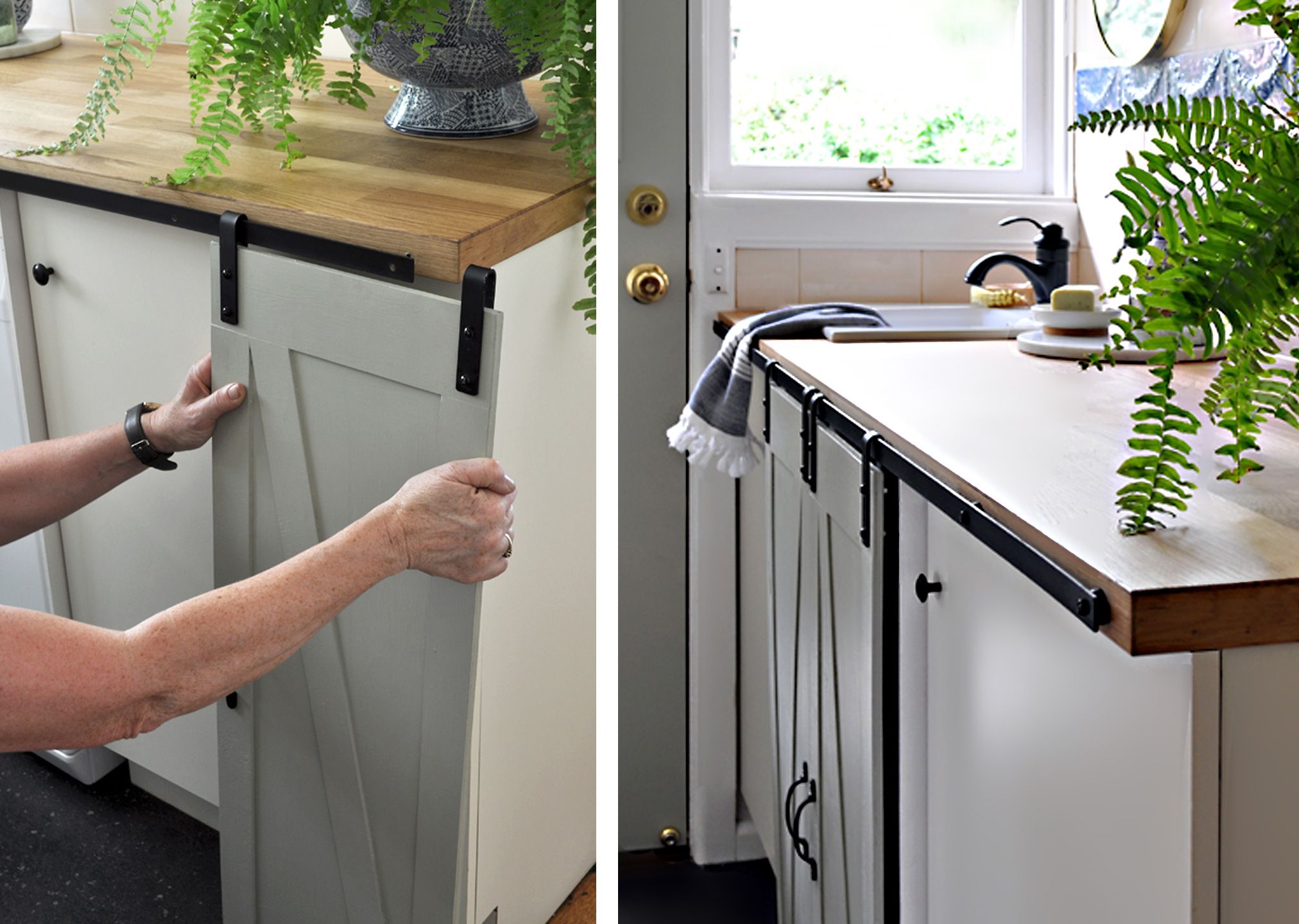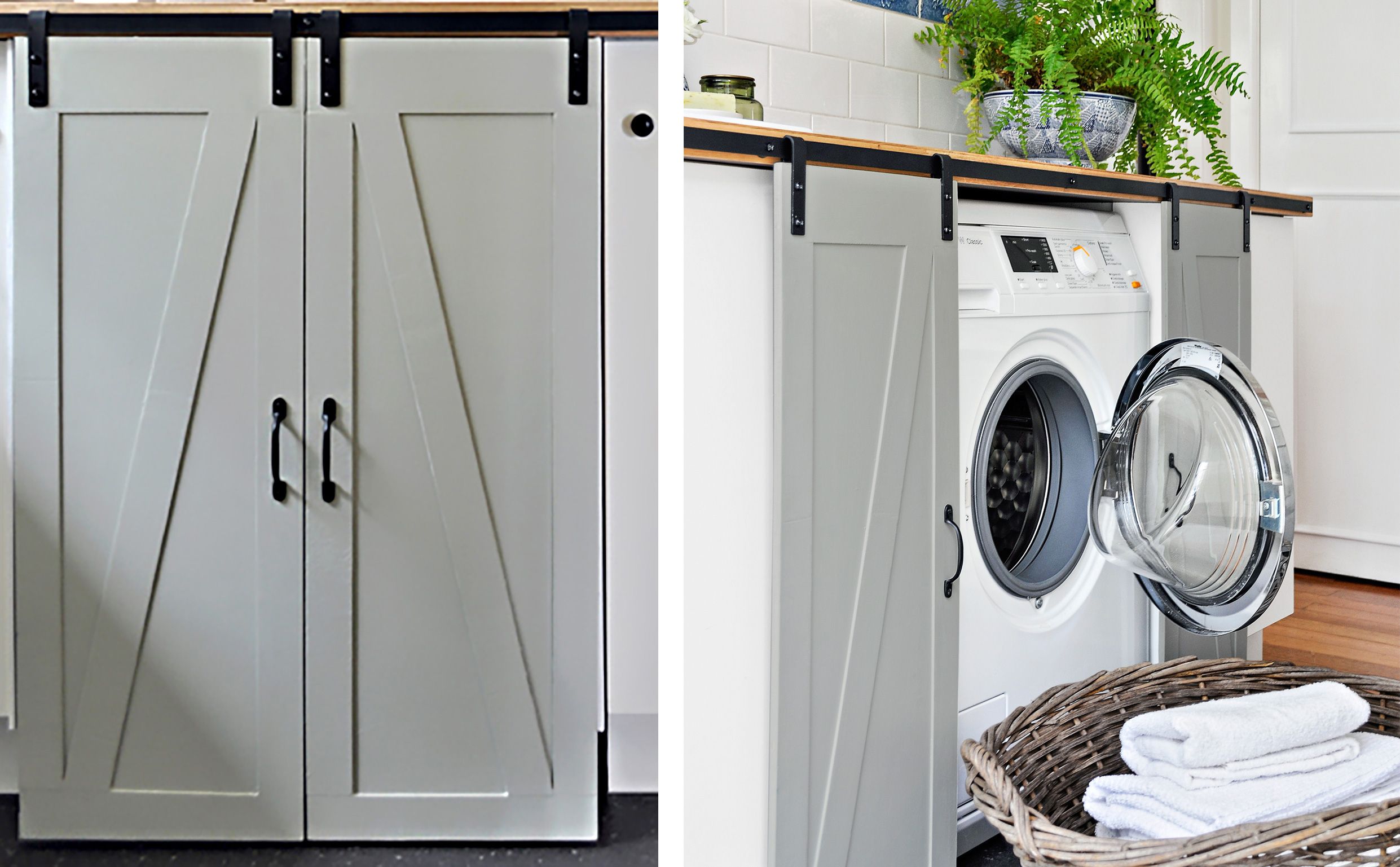Mini barn doors for cabinets can be a functional renovation for organizing your home. By creating your own mini barn dars, you can customize your living space while adding a unique design to your home’s decor. We’ll walk you through making and installing cabinet barn doors, providing you with the knowledge and skills to complete this simple DIY project.
Materials Needed for DIY Mini Barn Doors
Before starting your mini barn door project, you must gather all the necessary materials and tools. Preparing for this project will help in a smooth and simple building process.
Wood and Hardware Components
- 1-inch flat metal bar
- Decorative handles
- Metal garden-edging stakes
- Paint or stain of your choice
- Plywood sheets (7-mm thickness for the main panels)
- Rubber chair feet (for spacers)
- Screws and bolts
- Thin plywood (3-mm thickness for trim)
Tools Required
- Circular saw or table saw
- Clamps
- Drill and drill bits
- Measuring tape
- Paintbrush or roller
- Pencil
- Safety glasses and work gloves
- Sandpaper
- Screwdriver
Measuring and Planning Your Mini Barn Door Project
Proper planning and measurement can make or break any DIY project. Taking accurate measurements makes for a perfect fit and helps the doors to function smoothly.
Determining Cabinet Dimensions
Start by measuring the cabinet opening you want to cover. Measure the width and height of the opening, making sure to account for any trim or molding. You’ll want to measure in multiple places because some cabinet openings may not be perfectly square.
Calculating Door Size and Track Length
For a pair of sliding doors, each door should overlap the cabinet opening by at least 1 inch on all sides. To calculate the width of each door, add 2 inches to half the width of the cabinet opening. The height of the doors should be the height of the cabinet opening plus 2 inches.
The track length should be at least twice the width of one door so the cabinet can fully open. For example, if each door is 15 inches wide, your track should be at least 30 inches long.
Finalizing Your Measurements
After figuring out the correct door sizes and calculating the track length, double-check all your measurements for accuracy. For some, it can be helpful to sketch out your measurements and design plan on paper or use online software to visualize the completed look. This step can help prevent mistakes during the building process.
Crafting the Mini Barn Doors
Once you’ve confirmed all the measurements, it’s time to start building your mini barn doors. This process involves cutting the wood panels and assembling them into functional doors while adding customized design elements.

Cutting and Assembling the Door Panels
Using the appropriate measurements, cut the 7-mm plywood sheets for the main panels of your doors. For the trim, cut strips of 3-mm plywood to frame the edges of each door. Apply wood glue to attach the trim pieces to the main panels before clamping them in place overnight for a strong, secure bond.
Adding Decorative Elements
Once the glue has dried, sand the doors until they’re smooth and add any decorative elements you want to match your home. This could range from applying a crossbar design with additional wood strips to adding raised panels for a more traditional look. Always sand any added elements to create a more seamless appearance.
Sanding and Smoothing
After assembling the structure and adding decorative elements if desired, you have to sand the entire surface to smooth out any rough edges or splinters. The edges and corners should be slightly rounded to give a more professional-looking finish.
Installing the Sliding Hardware for Mini Barn Doors
The sliding mechanism is what gives barn doors their space-saving functionality. Creating a custom sliding system can save you money compared to purchasing pre-made hardware. However, if you’re newer to DIY products, you can purchase hardware and attach it to the doors.
Mounting the Track
Cut the 1-inch flat metal bar to the length you previously calculated for your track. Drill screw holes along the bar for mounting. Mark the position for the track on your cabinet or countertop, checking that everything is level. Pre-drill pillow holes, then attach the track using screws.
Attaching Door Hangers
You can repurpose metal garden-edging stakes as door hangers. Drill holes through both sides of each stake. Position the stakes on the doors, mark their placement, and drill holes in the door over the markings. Attach the stakes to the doors using nuts and bolts.
Testing and Adjusting
After mounting the track and attaching the door hangers, you’ll want to test the functionality of your doors. They should slide smoothly along the track, and you should check for any unevenness to confirm that the doors are balanced. Make any necessary adjustments to the hangers or track alignment for a more fluid movement.
Painting and Finishing Your Mini Barn Doors
The finishing touches can make a big difference in the appearance and design of your mini barn doors. Choose a paint or stain that complements your existing home decor.

Choosing the Right Paint or Stain
You should select a paint or stain that suits your home’s design and the overall look of the space where you’re installing the wood doors. If you’re aiming for a more rustic look, consider using a wood stain to highlight the natural grain. For a modern appearance, you should use solid-color paint in a matte or semi-gloss finish that matches your home’s color schemes.
Applying Protective Finishes
After painting or staining your doors, apply a clear protective finish to guard against wear and tear. This is especially necessary for doors that will be frequently used and susceptible to staining, such as your kitchen area. Allow the finish to dry completely before handling or installing the doors. Protective finishes prolong the life of wood surfaces, maintaining their appearance and functionality over time.
Mini Barn Door: Troubleshooting Common Issues
Even with careful planning and execution, you may encounter some challenges with your mini barn doors. From alignment to sliding mechanisms and loose hardware, we’ve put together a guide on how to address and fix each common issue.
Addressing Door Alignment Problems
If your doors aren’t hanging straight, check that your track is level and securely attached. Adjust the position of the door hangers if necessary, but you may also need to add shims behind the track for a very precise alignment.
Fixing Sliding Mechanism Glitches
If the doors aren’t sliding smoothly, check for enough clearance between the door and the surface below. Rubber chair feet can be used as spacers and should be adjusted to provide the right amount of lift. Always lubricate the track and hangers with a silicone-based lubricant for better sliding and more fluid movement.
Tightening Hardware Components
Another common issue may involve hardware becoming loose over time. Periodically check the bolts, screws, and nuts to ensure everything is tight and secure. Loose components can cause the doors to misalign or not slide smoothly.
Creative Applications for Mini Barn Doors
Mini barn doors offer many solutions for your storage and concealment needs to create a clean space in your home. Mini barn doors are a versatile addition to your home, so we’ve compiled some creative ways to incorporate them into your living space.

Concealing Appliances and Electronics
Mini barn doors are great for hiding appliances and electronics you don’t want on constant display. For instance, you can use them to cover a washer and driver in a laundry area or hide a wall-hung TV cabinet in your living room. This allows you to maintain a clean, uncluttered look while keeping these items easily accessible.
Additional Storage Spaces
Mini barn doors can also be used to create more organized storage solutions. You can install them on bathroom vanities, kitchen pantries, or even walk-in closets. Their sliding design makes them great for tighter spaces where traditional swing-out doors might be impractical.
Customizing Furniture Pieces
Incorporating mini barn doors into custom furniture pieces such as bookshelves or entertainment centers can help your home appear less cluttered and add a personalized touch to your furniture, both in style and functionality.
Maintaining Your Mini Barn Door Cabinets
Regular maintenance helps keep your mini barn doors functioning well. Periodically checking the track and hangers for any signs of wear or loosening and addressing these issues will keep your doors working properly. You should also regularly tighten any loose screws and lubricate the sliding mechanism as needed.
Clean the doors regularly with a soft, damp cloth to remove dust and dirt. Avoid using harsh chemicals that could damage the finish, and touch up any chips or scratches as you notice them to prevent further damage.
Scheduled Maintenance
Implementing a regular maintenance schedule to inspect the sliding mechanism and door surfaces can help identify and resolve issues before they become more significant problems. Without addressing these, your doors may stop working properly and require new parts or a more in-depth maintenance task.
Seasonal Adjustments
Wood can expand and contract with changing humidity and temperature conditions. Be prepared to adjust the sliding hardware to prevent warping and ensure smooth operation throughout the year. Using humidifiers in the winter and dehumidifiers in the summer can help prevent the wood on your barn doors from being affected by seasonal changes.
Cost-Saving Tips for DIY Mini Barn Doors
Creating your own mini barn doors can be a cost-effective alternative to purchasing pre-made versions. Here are some tips to keep your project budget-friendly:
- Use reclaimed wood for a rustic look and reduced material costs.
- You can create simple hardware designs, like repurposed garden stakes mentioned earlier.
- Choose affordable paint or stain options that will still provide a clean finish.
- Consider using concealed cabinet hinges for a professional look without the cost of specialized barn door hardware.
- Repurpose existing cabinet doors by adding trim and converting them to sliding doors.
Purchasing materials in bulk can be more cost-effective. Wood, screws, and paint often have discounts when bought in larger quantities. This can reduce the overall cost of building your mini barn doors and provide supplies for future DIY projects.

